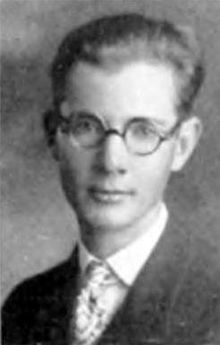Fred Whipple
Fred Lawrence Whipple (born November 5, 1906 in Red Oak / Iowa ; † August 30, 2004 in Cambridge / Mass. ) Was an American astronomer and from 1955 head of the Smithsonian Astrophysical Observatory (SAO). The main focal points of his work were comet research (“dirty snowballs”) and optical observation methods for earth satellites, for which he founded the SAO's Moonwatch organization at the SAO and advanced the development of the Baker-Nunn camera .
Life
Whipple grew up on a farm in Iowa until his family moved to Los Angeles . He went to college, doing a job at his father's grocery store, where he advised customers and at the same time calculated the subtotal of their purchases in his head. He liked numbers. His wish to become a tennis player was not fulfilled because he contracted polio . After that, he studied mathematics and decided to become an astronomer.
Even when he was doing his doctorate at the University of California, Berkeley , he was involved in calculating the orbit of the newly discovered dwarf planet (then still the ninth planet ) Pluto . Then he went to the College Observatory at Harvard University , processed thousands of photographic plates of celestial images and concentrated on researching comets and meteorites .
In 1933 he discovered the periodic comet 36P / Whipple and the asteroid (1252) Celestia . He was also the discoverer or co-discoverer of five non-periodic comets, including C / 1932 P1 Peltier-Whipple. He discovered the latter independently of Leslie Copus Peltier , the amateur astronomer known for the later award of the prize .
During the Second World War he developed aluminum reflectors for the Harvard Radio Research Laboratories to interfere with German radar systems. Whipple is best known for his disruptive contribution to comet research - the concept of "dirty snowballs" for the composition of comets , which he suggested in a 1950 article in the Astrophysical Journal . He originally used the term "icy conglomerate".
In 1955 he became head of the Smithsonian Astrophysical Observatory (SAO). Here he developed an optical tracking system for celestial bodies, a series of so-called Baker-Nunn cameras . After the start of the Russian Sputnik in October 1957, which was surprising for the USA , the manufacturers in South Pasadena hastily assembled the first camera in order to take pictures of this "wonder thing". Because the USA was also preparing satellite launches, Whipple had founded the Moonwatch organization in 1956 , in which amateur astronomers from all over the world contributed to determining the orbit of the earth's satellites. It was only dissolved around 1980, when the electronic measuring processes were perfected.
Fred Whipple refined observation techniques and devices, worked with photography and ballistics to calculate the speed of meteors . When the SAO observatory opened in 1973 at the Harvard-Smithsonian Center for Astrophysics , he continued research there. At the age of 92, “Dr. Comet ”for NASA's Comet program Contour . The unmanned research device took off in the summer of 2002. Whipple hoped to be 100 years old in order to still experience his planned 2006 meeting with the comet Schwassmann-Wachmann 3 . Whipple was the first to calculate an exact orbit of Pluto.
He developed the " Whipple Shield ", a type of high-speed impact shield used to protect manned and unmanned spacecraft from collisions with micrometeorites and space debris, the speeds of which are generally between 3 and 18 km / s.
Memberships
In 1941 Whipple was elected to the American Academy of Arts and Sciences , in 1956 to the American Philosophical Society and in 1959 to the National Academy of Sciences , whose J. Lawrence Smith Medal he had received in 1949.
Honors
- 1983 Gold Medal from the Royal Astronomical Society
- 1986 Bruce Medal
- 1987 Henry Norris Russell Lectureship
- An observatory on Mount Hopkins near Amado, Arizona is called the Fred Lawrence Whipple Observatory .
- The asteroid (1940) Whipple was named in his honor .
- The Whipple lunar crater bears his name.
Works
- Earth, moon and planets . - Cambridge, Mass .: Harvard Univ. Pr., 1952
- The mystery of comets . - Cambridge, Mass .: Cambridge Univ. Pr., 1986. - ISBN 0-521-32440-8
- Orbiting the sun: planets and satellites of the solar system . - Cambridge, Mass .: Harvard Univ. Pr., 1981. - ISBN 0-674-64125-6
- Dirty snowball paper: Part I: ApJ 111 (1950) 375; Part II: ApJ 113 (1951) 464
Web links
- Literature by and about Fred Whipple in the catalog of the German National Library
- Publications by FL Whipple in the Astrophysics Data System
- Obituaries for FL Whipple in the Astrophysics Data System
- Dirty snowballs (obituary in the FAZ of September 2, 2004)
- Fred Lawrence Whipple Observatory (FLWO)
Individual evidence
- ↑ Book of Members 1780 – present, Chapter W. (PDF; 852 kB) In: American Academy of Arts and Sciences (amacad.org). Retrieved February 24, 2018 .
- ^ Member History: Fred L. Whipple. American Philosophical Society, accessed November 17, 2018 .
| personal data | |
|---|---|
| SURNAME | Whipple, Fred |
| ALTERNATIVE NAMES | Whipple, Fred Lawrence |
| BRIEF DESCRIPTION | American astronomer |
| DATE OF BIRTH | 5th November 1906 |
| PLACE OF BIRTH | Red Oak , Iowa , USA |
| DATE OF DEATH | August 30, 2004 |
| Place of death | Cambridge , Massachusetts , USA |
